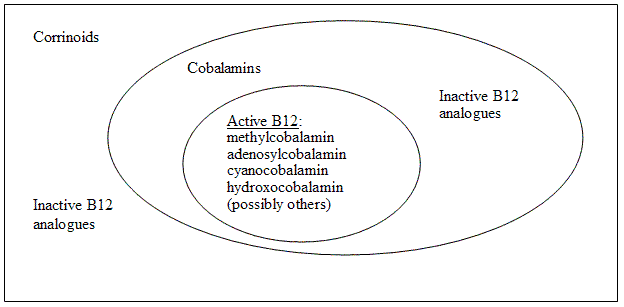Contents
- Active and Inactive Analogues
- B12 in Animal Foods
- Inactive Analogues: Worse than Useless
- Weeding Out Inactive Analogues
- References
Active and Inactive Analogues
Vitamin B12 is a coenzyme: it is needed for enzymes to do their job of changing one molecule into another.
As vitamins go, B12 is large. One part of its structure is known as the corrin nucleus, which holds an atom of cobalt. The corrin resembles the heme of hemoglobin which holds an atom of iron. Any molecule that contains a corrin nucleus is considered a corrinoid.
The corrin plus other atoms make up the cobalamin part of B12. There are many different cobalamins and they are named after their attachments. For example, methylcobalamin is cobalamin with a methyl group (one carbon and three hydrogens) attached.
Only two cobalamins are active as coenzymes in the human body: adenosylcobalamin and methylcobalamin. The body has the ability to convert at least some other cobalamins into one of these active forms.
Cyanocobalamin (a cyanide molecule attached to a cobalamin) is the form most often found in supplements and fortified foods because it is the most stable form of B12. The cyanide in cyanocobalamin is in amounts small enough not to be harmful to anyone except possibly those with cyanide metabolism defects—see Safety of Cyanocobalamin.
Most people readily convert cyanocobalamin into one of the B12 coenzymes (1).
Hydroxocobalamin is also common in foods and the body; it can be converted into a B12 coenzyme.
All corrinoids (including all cobalamins) are considered B12 analogues. Many corrinoids, and possibly even some cobalamins, are not usable by human B12 enzymes. These are considered inactive B12 analogues.

About 1/3 of the corrinoids in the typical person are inactive analogues, while the rest are active B12 (2).
B12 in Animal Foods
In animal foods, B12 is protein-bound and partially light-protected (4).
It is mostly in the form of adenosylcobalamin and hydroxocobalamin. In cow’s milk it is mainly adenosylcobalamin, but in dried milk it is mostly hydroxocobalamin with a trace of cyanocobalamin. Egg yolks and sardines contain a substantial proportion of methylcobalamin (4).
Inactive Analogues: Worse than Useless
Carmel et al. (3) (1988, USA) examined the medical records of 364 patients with low B12 levels. Both R-protein and human intrinsic factor were used to measure their B12 levels. Because active B12 analogues would be detected using either method, any difference between the two methods would indicate inactive B12 analogues. Results were:
- Patients with primarily neurological problems had significantly higher inactive B12 analogue levels (as shown by a difference between assays), than did patients with primarily blood problems.
- 33 of the 76 patients with neurological symptoms had a normal serum B12 when measured with R-protein. But when measured with intrinsic factor, many of these patients had much lower serum B12 levels.
- The R-protein assay was a reliable indicator of B12 deficiency in patients whose symptoms were primarily blood-related.
This study indicates that some B12 analogues may be harmful to the nervous system or that some B12 analogues may have B12 activity in bone marrow (which produces blood cells) but not in the nervous tissue.
Weeding Out Inactive Analogues
There are basically three B12 analogue transport proteins (5):
- Intrinsic Factor – Facilitates uptake of B12 analogues into the intestinal cells in the ileum. Has a low affinity for many inactive analogues.
- Transcobalamin – Facilitates uptake of B12 analogues into all cells in the body. Has a low affinity for many inactive analogues.
- Haptocorrin – Facilitates uptake of B12 analogues into the liver cells. Has a high affinity for many inactive analogues.
Haptocorrin delivers B12 analogues to the liver where the inactive analogues are excreted in the urine and feces (5). Active B12 is released back into the blood (5), where it is taken to cells by transcobalamin.
References
1. Herbert V. Vitamin B-12: plant sources, requirements, and assay. Am J Clin Nutr. 1988;48:852-8.
2. Herbert V. Staging vitamin B-12 (cobalamin) status in vegetarians. Am J Clin Nutr. 1994 May;59(5 Suppl):1213S-1222S.
3. Carmel R, Karnaze DS, Weiner JM. Neurologic abnormalities in cobalamin deficiency are associated with higher cobalamin ‘analogue’ values than are hematologic abnormalities. J Lab Clin Med. 1988 Jan;111(1):57-62.
4. Linnell JC, Matthews DM. Cobalamin metabolism and its clinical aspects. Clin Sci (Lond). 1984 Feb;66(2):113-21.
5. Allen RH, Stabler SP. Identification and quantitation of cobalamin and cobalamin analogues in human feces. Am J Clin Nutr. 2008 May;87(5):1324-35.

2 thoughts on “Vitamin B12 Analogues”
I’m wondering, for a vegetarian or vegan taking spirulina or AFA for other nutrition benefits, whether it’s possible to ameliorate the problem of inactive B12 analogues by supplementing with real B12, perhaps after a certain time lag?
We don’t have any evidence that inactive analogs can negate the benefits of supplementing with B12, but it’s probably a good idea to avoid taking them within 6 hours of each other.